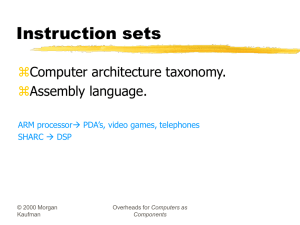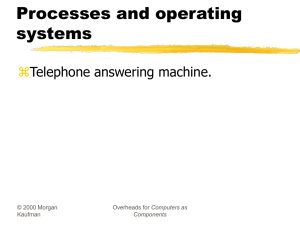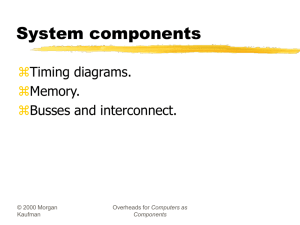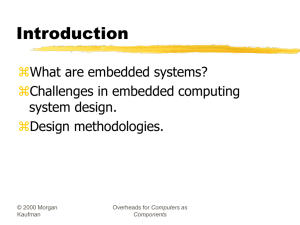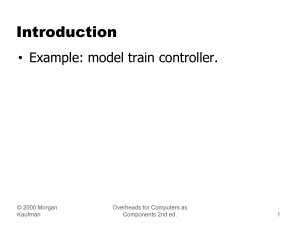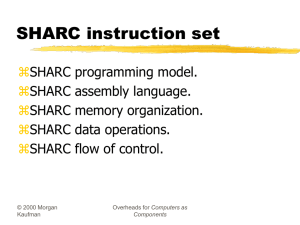ch6-2 - Waynewolf.us
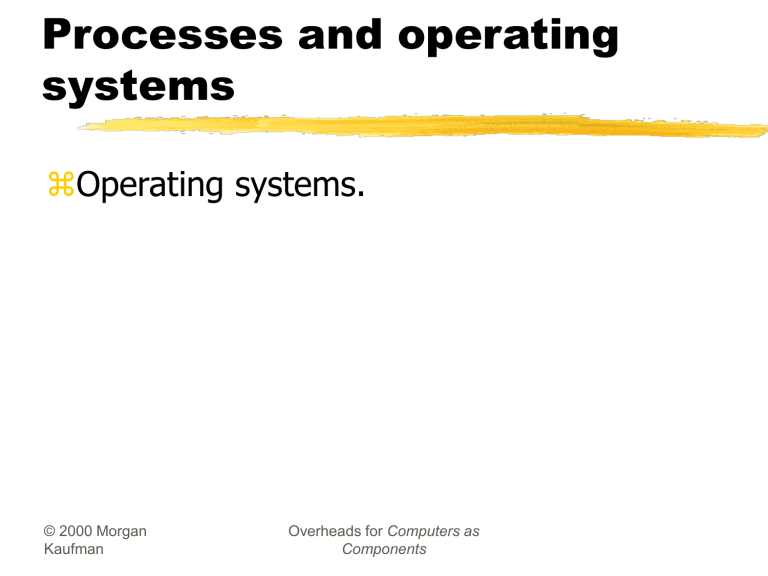
Processes and operating systems
Operating systems.
© 2000 Morgan
Kaufman
Overheads for Computers as
Components
Operating systems
The operating system controls resources:
who gets the CPU;
when I/O takes place;
how much memory is allocated.
The most important resource is the CPU itself.
CPU access controlled by the scheduler.
© 2000 Morgan
Kaufman
Overheads for Computers as
Components
Process state
A process can be in one of three states:
executing on the CPU;
ready to run;
waiting for data.
gets
CPU ready executing preempted needs data gets data and CPU gets data waiting needs data
© 2000 Morgan
Kaufman
Overheads for Computers as
Components
Operating system structure
OS needs to keep track of:
process priorities;
scheduling state;
process activation record.
Processes may be created:
statically before system starts;
dynamically during execution.
© 2000 Morgan
Kaufman
Overheads for Computers as
Components
Embedded vs. generalpurpose scheduling
Workstations try to avoid starving processes of CPU access.
Fairness = access to CPU.
Embedded systems must meet deadlines.
Low-priority processes may not run for a long time.
© 2000 Morgan
Kaufman
Overheads for Computers as
Components
Priority-driven scheduling
Each process has a priority.
CPU goes to highest-priority process that is ready.
Priorities determine scheduling policy:
fixed priority;
time-varying priorities.
© 2000 Morgan
Kaufman
Overheads for Computers as
Components
Priority-driven scheduling example
Rules:
each process has a fixed priority (1 highest);
highest-priority ready process gets CPU;
process continues until done.
Processes
P1: priority 1, execution time 10
P2: priority 2, execution time 30
P3: priority 3, execution time 20
© 2000 Morgan
Kaufman
Overheads for Computers as
Components
Priority-driven scheduling example
P3 ready t=18
P2 ready t=0 P1 ready t=15
P2
0
© 2000 Morgan
Kaufman
10
P1 P2
20 30
Overheads for Computers as
Components
40
P3
50 time
60
The scheduling problem
Can we meet all deadlines?
Must be able to meet deadlines in all cases.
How much CPU horsepower do we need to meet our deadlines?
© 2000 Morgan
Kaufman
Overheads for Computers as
Components
Process initiation disciplines
Periodic process : executes on (almost) every period.
Aperiodic process : executes on demand.
Analyzing aperiodic process sets is harder-
--must consider worst-case combinations of process activations.
© 2000 Morgan
Kaufman
Overheads for Computers as
Components
Timing requirements on processes
Period : interval between process activations.
Initiation interval : reciprocal of period.
Initiation time : time at which process becomes ready.
Deadline : time at which process must finish.
© 2000 Morgan
Kaufman
Overheads for Computers as
Components
Timing violations
What happens if a process doesn’t finish by its deadline?
Hard deadline : system fails if missed.
Soft deadline : user may notice, but system doesn’t necessarily fail.
© 2000 Morgan
Kaufman
Overheads for Computers as
Components
Example: Space Shuttle software error
Space Shuttle’s first launch was delayed by a software timing error:
Primary control system PASS and backup system BFS.
BFS failed to synchronize with PASS.
Change to one routine added delay that threw off start time calculation.
1 in 67 chance of timing problem.
© 2000 Morgan
Kaufman
Overheads for Computers as
Components
Interprocess communication
Interprocess communication ( IPC ): OS provides mechanisms so that processes can pass data.
Two types of semantics:
blocking : sending process waits for response;
non-blocking : sending process continues.
© 2000 Morgan
Kaufman
Overheads for Computers as
Components
IPC styles
Shared memory:
processes have some memory in common;
must cooperate to avoid destroying/missing messages.
Message passing:
processes send messages along a communication channel---no common address space.
© 2000 Morgan
Kaufman
Overheads for Computers as
Components
Shared memory
Shared memory on a bus:
CPU 1 memory
CPU 2
© 2000 Morgan
Kaufman
Overheads for Computers as
Components
Race condition in shared memory
Problem when two CPUs try to write the same location:
CPU 1 reads flag and sees 0.
CPU 2 reads flag and sees 0.
CPU 1 sets flag to one and writes location.
CPU 2 sets flag to one and overwrites location.
© 2000 Morgan
Kaufman
Overheads for Computers as
Components
Atomic test-and-set
Problem can be solved with an atomic test-and-set:
single bus operation reads memory location, tests it, writes it.
ARM test-and-set provided by SWP:
ADR r0,SEMAPHORE
LDR r1,#1
GETFLAG SWP r1,r1,[r0]
BNZ GETFLAG
© 2000 Morgan
Kaufman
Overheads for Computers as
Components
Critical regions
Critical region : section of code that cannot be interrupted by another process.
Examples:
writing shared memory;
accessing I/O device.
© 2000 Morgan
Kaufman
Overheads for Computers as
Components
Semaphores
Semaphore : OS primitive for controlling access to critical regions.
Protocol:
Get access to semaphore with P().
Perform critical region operations.
Release semaphore with V().
© 2000 Morgan
Kaufman
Overheads for Computers as
Components
Message passing
Message passing on a network:
© 2000 Morgan
Kaufman
CPU 1 message message
Overheads for Computers as
Components
CPU 2 message
Process data dependencies
One process may not be able to start until another finishes.
Data dependencies defined in a task graph .
All processes in one task run at the same rate.
© 2000 Morgan
Kaufman
Overheads for Computers as
Components
P1
P3
P4
P2
Other operating system functions
Date/time.
File system.
Networking.
Security.
© 2000 Morgan
Kaufman
Overheads for Computers as
Components
